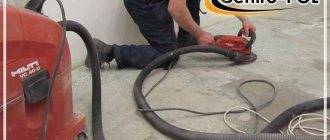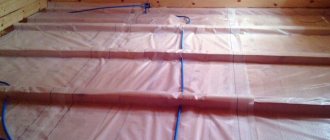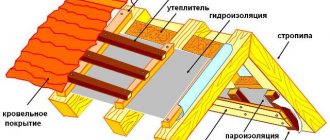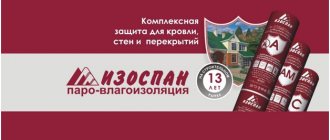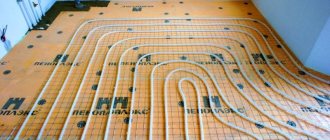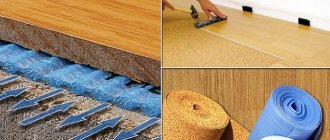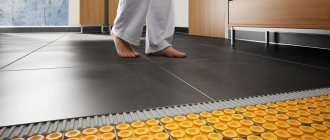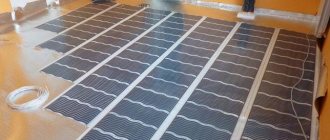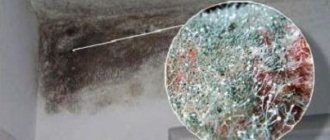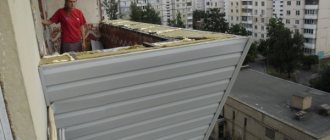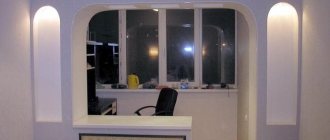Why is vapor barrier necessary?
The weather in the off-season is changeable. The air temperature can fall and rise. Insulation with special means will protect against condensation formed during the appearance of steam. Gradually the walls, floor and ceiling of the balcony will become damp.
This can lead to the appearance of fungus, which will be difficult to get rid of.
Many people believe that if the conditions on the street are always normal (for example, in the southern part), then such a process can be dispensed with. This is not true; vapor barrier is necessary for all closed loggias, without exception.
Main characteristics of vapor barrier materials
Vapor barrier layer:
- reliably waterproofs the room, thereby eliminating the appearance of condensation;
- retains the qualities of a sound-absorbing and heat-insulating layer;
- serves as a barrier against moisture.
Based on all of the above, it is clear that it is impossible to do without a vapor barrier when finishing a balcony.
When buying waterproofing with such properties in a store, keep in mind that the reliability of the waterproofing depends on the strength index. The larger this parameter, the more reliable it is. The most convenient are insulating products that do not need to be secured in complex ways. It will also be important what water pressure such a waterproofing material can withstand. This characteristic will guarantee that moisture will not penetrate into the room.
Types of vapor barrier
Vapor barriers have different purposes. Vapor-permeable membranes and films are most often used for finishing balconies. In the first case, steam cannot pass through the product. Insulating films prevent moisture from entering from the street. They protect against heat loss and even the strongest winds.
The vapor barrier layer should be under the insulation (for example, under mineral wool). Mineral wool has very poor protection against condensation penetration, so covering with a waterproofing layer will not be superfluous. You can use aluminum foil film or polyethylene with a reinforced coating for this purpose. If such a waterproofing agent is used, good ventilation in the loggia is necessary.
Moisture does not accumulate on some types of vapor barrier. Their anti-condensation properties are due to the existing fabric layer on the reverse side. The liquid accumulates on this coating and does not escape into the room. The film is laid so that the fabric side is on the bottom. The size between it and the insulation should be about 5-7 cm.
Vapor-permeable membranes are suitable for thermal insulation of the outer side of the walls of a balcony or its roof. In the latter case, such an insulator is applied to the top layer. Thanks to this, moisture accumulates only on the insulation and does not enter the loggia.
The main advantages of insulating a balcony or loggia
Would you like to increase your living space in an apartment by one small room up to eight square meters? Any owner of a small apartment will answer this question in the affirmative. Such a solution can be implemented even by an ordinary person who has no experience in construction.
The space of a balcony or loggia allows a very good opportunity to increase the space of your home.
A unique option is to organize a room for friends in an apartment, or to arrange a so-called winter garden in your home, or simply to create an isolated place for relaxation.
The external wall of a balcony or loggia is not able to cope with the heat retention function.
The installation of ordinary hermetic window blocks and modern installation during insulation of extruded Penoplex polystyrene foam can transform a small room, which will be able to retain heat during severe frosts and prevent the room from becoming too hot during sultry heat.
First, let’s determine what work you can do yourself and what you can entrust to qualified specialists to do. It is best if the glazing of the balcony (loggia) and the laying of the parapet are done by real professionals.
Glazing of an additional room is best done using a double-glazed window consisting of two chambers and a thickness of at least 32 mm. It is best to order double-glazed windows from well-known and trusted companies.
When insulating your balcony or loggia with penoplex, you need to achieve the so-called thermos effect. This means that you need to insulate the floor, walls, ceiling, parapet, creating a closed, hermetically sealed space.
In order to save useful space in an insulated room, the thermal conductivity of the insulating material is of great importance.
Even in areas with very harsh and harsh climatic conditions, penoplex insulation will create a comfortable microclimate on the balcony or loggia. For thermal insulation of a balcony (loggia) that is combined with a living room, it is recommended to use Penoplex from 40 to 60 mm thick.
For many regions where the average temperature in winter is about 20-25 degrees below zero, it is enough to use a panel whose thickness is about 50 mm.
Membrane types
Membranes with vapor barrier characteristics are divided into several types:
- Pseudo-diffusion (perforated). Essentially these are reinforced films or combined fabrics with small holes across the entire surface. Their vapor permeability coefficient is approximately 300 g/m². These membranes are used for waterproofing under roofs. Among the disadvantages, they note the possible entry of dust into the perforations or blockage of the holes with frost during the cold season.
- Diffusion (porous). Their structure is similar to fiber. The pores of these membranes become clogged differently than those of perforated membranes. Therefore, they are the preferred means of creating an air layer over the insulation. Its vapor permeability coefficient is at the level of 1000 g/m².
- Superdiffusion (multilayer). These membranes are assembled in several layers. They do not clog because they are not perforated. This vapor barrier element is suitable for arranging balconies in areas with high dust levels. Pollution and moisture will not penetrate into the room through it. The condensate permeability coefficient ranges from 900 to 2500 g/m².
Membranes made from three layers are considered the highest quality and most expensive.
The most commonly used is their two-layer variety.
Finishing the loggia with a vapor barrier: the best materials
Manufacturers offer a large number of layers for vapor insulation:
- Tyvek from DuPont . It has increased elasticity and strength. This membrane from the Luxembourg brand can be used in any climate. Thanks to special layers, the balcony will not be stuffy.
- Yutafol . The Czech development does not allow moisture to pass through, and condensation evaporates from the surface of the walls and floor without obstacles. Most often used on sloping roofs.
- Penoizol . A popular layer for vapor barrier on loggias. Thanks to its special composition, the substance can retain moisture and evaporate it over time.
- Delta. Such materials from the German brand are characterized by high strength and long service life.
- Megaisol . Has excellent insulating properties. Can be pasted on the ceiling, walls and floor. It must be laid on top of the insulating fiber. The metallized coating reliably protects against moisture penetration, and the inner layer traps fumes inside and prevents them from lingering on the loggia.
- Izospan . It simultaneously serves as insulation and isolates steam on the balcony. Provides excellent insulation and does a good job of removing moisture from any internal structure.
- Penofol . It has good thermal conductivity, flexibility and water resistance. The membrane is very thin, but at the same time it protects well from frost getting inside.
In addition to all of the above, liquid rubber is popular in waterproofing balconies. This material serves as good protection for reinforced concrete joints and connections.
The order of work on insulating balconies and loggias
Let's briefly look at the first stage - glazing. For your balcony, choose a manufacturer that has proven itself in the market, do not go for cheapness. Double-glazed windows – double-chamber, at least 32 mm. All gaps must be carefully filled with foam.
First stage
Preparing the walls. This work consists of applying a two-layer waterproofing coating. We first clean the surfaces from dirt and treat them with an antiseptic.
Ignoring this stage of work is the main mistake when insulating balcony walls. The lack of waterproofing will allow moisture to penetrate deeper; without an antiseptic, mold will quickly develop in these conditions. (read: what methods and materials can be used to waterproof).
Second phase
At this stage, we proceed to covering the walls and fences directly with extruded polystyrene foam. This work is carried out quite quickly - the material is light in weight and easy to process. Attached to the walls with special plastic dowels with a wide head. We must fill the joints with polyurethane foam. Expanded polystyrene slabs are attached to the ceiling in the same way as wall slabs; you can play it safe by adding special glue.
Third stage
We install a vapor barrier layer. Be sure to glue the vapor barrier to the inside of the polystyrene foam boards - this is not an applicable condition. By attaching a vapor barrier between the insulation and the wall, we are guaranteed to get condensation. To create a greater effect, we attach a foil film over the vapor barrier. But, you can get by with one material that combines the properties of a vapor barrier and a heat reflector, using penofol in this capacity. Be sure to seal the joints with foil tape to prevent the penetration of moisture vapor.
Next, we attach wooden slats onto which we mount the finishing material - gypsum fiber sheets (gypsum fiber sheets) or gypsum board (plasterboard sheets), plastic panels or MDF panels.
Advice: if the neighbors above have insulated the floors of their balcony, you don’t have to insulate the ceiling.
Fourth stage
Let's move on to floor insulation. The material for this work must have high strength and withstand increased loads. Expanded polystyrene is ideal for this purpose.
We treat the leveled screed with an antiseptic, on top of which we apply two layers of waterproofing. We tightly lay sheets of insulation between the exposed wooden logs and cover it with a vapor barrier layer on top. We attach OSB sheets to the joists - the basis of the future floor covering. (read about additional methods of floor insulation).
Final stage
All that remains is finishing work and installation of decorative cladding. There are options to cover the walls with plasterboard followed by appropriate finishing or simply with wooden paneling.
The flooring is made from tongue-and-groove floorboards, tiles glued to the base surface, electrically heated concrete screed, etc.
We looked at the process of insulating a loggia. The work is not the easiest, but quite doable. It is important to remember that it all starts with the right insulation and well-carried out work. Subsequently, the presence of heating on the balcony will not give the expected effect if these points are ignored.
Source: remont-troick.ru
Preparatory work
Many home craftsmen are interested in how to make a vapor barrier under insulation on a loggia and is it difficult? Protection against condensation must be carried out before insulation. To make it, you need to remove the debris, remove the balcony threshold and door frame. If there are gaps or cracks, they should be sealed with foam installation foam.
After it dries, it is necessary to eliminate the irregularities by cutting them off with a construction knife. The vapor barrier layer can be installed when the wall surface is completely ready.
Laying the material will vary depending on its type:
- when insulating the ceiling, the steam film is attached to the insulation;
- for internal cladding with foam plastic or mineral wool, insulation is laid between the layers;
- installation on the outside of insulating materials is carried out if the facade is insulated from the outside.
Some anti-moisture products have a fabric side. When installing it, this surface is positioned so that it “looks” outward. If internal insulation is carried out with a foil membrane, it is placed on the inside of the walls.
Preparation and calculations
The designer must consider measures to insulate the foundation at the design stage of the load-bearing structure . To implement high-quality thermal insulation, a specialist needs to know the climatic and geological characteristics of the site, the design pressure from the structure to the base, as well as the design characteristics of the slab itself.
When choosing penoplex as insulation, as a rule, they are guided by its advantageous properties. In this case, before construction, you need to calculate the optimal thickness of the slab and determine the total need for raw materials in order to prepare an estimate.
When insulating the foundation, in addition to the penoplex itself, you will also need an adhesive solution in the form of a mixture, or polyurethane foam, as well as a tool for cutting slabs.
Insulation thickness
When constructing a slab base, experts recommend using penoplex with a density close to 45 kg/m3 and a sheet thickness from 20 to 100 mm . Moreover, the lower the ambient temperature in the winter season, the thicker and denser the insulation should be.
As a rule, on the packaging of penoplex, the manufacturer provides recommendations for choosing the type of penoplex depending on the conditions of use - for areas with different temperatures. But it is advisable for an individual developer to calculate the value himself indicatively relative to the design conditions. The formula is taken as a basis:
Where:
- R – regional resistance to heat transfer;
- h1 – thickness of the foundation slab;
- h2 – insulation thickness;
- λ1 – thermal conductivity coefficient of concrete;
- λ2 – thermal conductivity coefficient of penoplex.
In the presented formula, the unknown quantity is h2, and the remaining indicators are taken from official reference books. The thickness of the insulation is always rounded up, leaving a margin for unforeseen situations.
The total need for penoplex is determined based on the area of the base and one factory slab. For thorough thermal insulation of the foundation, penoplex is laid in two layers, shifting the slabs in a checkerboard pattern so that the integrity of the structure is not compromised during operation.
Vapor barrier of the floor on the balcony
To insulate this area of the loggia from steam, a slatted sheathing is installed. After it, a vapor barrier strip is placed. Boards or plywood will serve as the floor surface. Linoleum or laminate should be laid on top of them. In the latter case, an additional thin polyurethane backing is needed.
Be sure to place vents in the space under the floor. They need to be connected to ventilation ducts. Then the vapor barrier of the balcony will function normally.
To create insulation from steam and at the same time insulate the floor, you can use Izospan. This material is cut into small rectangular pieces and overlapped. Its size should be about 8-10 cm. To prevent the edges of the vapor barrier gasket from coming apart, they are glued with construction tape.
2.1 Vapor barrier of balconies and loggias
Penoplex is most often used for balconies and loggias. This is due to the fact that this material has very low weight and high strength. Even for a hollow balcony, a slab up to 7-8 cm thick should be sufficient.
As for the use of vapor barrier, here it is really needed.
A fitted penoplex will, of course, eliminate most of the openings, but it is simply impossible to fit it perfectly. At the same time, steam and condensation most often form on balconies. After all, they are in contact with the street throughout their entire area.
Loggia protected by an additional layer of vapor barrier
And the area of window glass (namely, they most often have a lower temperature) on the balcony and loggia is much larger.
Therefore, a vapor barrier on the balcony is needed. Moreover, it is recommended to use not even ordinary membranes, but foil-clad polyethylene with a foam base.
The base will further stabilize all processes and will not allow steam to pass through, and the foil will be able to repel heat waves into the room.
Thus, you will completely get rid of the problem of steam penetration, condensation and excessive waste of thermal resources. In addition, you don’t have to spend a lot of money on a vapor barrier for a balcony.
Balcony vapor barrier during insulation
Anti-condensation devices are installed in different ways. Which one is preferred will depend on the purpose of the material. For example, a vapor barrier film can be used to insulate the walls inside a balcony. In this case, it is glued from the side of the room on top of the insulation.
Anti-condensation membranes are installed on the side facing the street. Using these means, moisture is removed from the thermal insulation. The vapor barrier of the loggia is carried out in different ways, depending on the material that was used.
For example, if there is a foil or anti-condensation (fabric) layer on the film, it must be located indoors. With two identical sides, it can be laid in any way you like. Diffusion materials to prevent steam penetration into the loggia have different surface colors. Which side should be used to lay such a moisture-retaining product is written in the instructions from the manufacturer.
Type of vapor barrier
The materials used for vapor barrier differ in their purpose. So, in the construction of various objects, two main types of products can be used:
- Vapor-permeable membranes;
- Vapor-proof films.
That is, the first option implies that water vapor does not pass through the product, and the second type is installed if it is necessary to remove steam from the room and prevent it from penetrating inside. Another advantage of vapor-permeable membranes is that they can protect against wind, and therefore heat loss.
Vapor-permeable membrane for vapor barrier of balcony and loggia
The vapor barrier layer should be located under a layer of insulation, which can be, for example, mineral wool. For such materials, the coefficient of vapor permeability is minimal. In particular, polyethylene film has such qualities. However, it is worth keeping in mind that it has low strength, so it is recommended to use reinforced polyethylene or films with aluminum foil coating.
It is also necessary to take into account that when using this type of material, care should be taken to ensure good ventilation. Read also - supply valve for plastic windows.
Some vapor barrier products have anti-condensation properties, that is, moisture does not accumulate on them. This quality is achieved due to the presence of a fabric layer on the reverse side, which collects liquid on itself. Such materials are used on coatings with low corrosion resistance, for example, for corrugated sheets, metal tiles or galvanized sheets. The film is laid with the fabric side down, and it is important to maintain the distance to the insulation (up to 6 cm).
Film vapor barrier material
As for vapor-permeable membranes, they should be used for the top layer of the roofing pie or for thermal insulation of walls from the outside. Such materials allow the moisture that accumulates on the insulation to be removed and at the same time not to allow it to pass inside. There are several types of such products:
- perforated (pseudo-diffusion) - membranes are combined fabrics or reinforced films with small punctured holes. Their vapor permeability coefficient is up to 300 g/m². Most often, such material is used for under-roof waterproofing. Their main disadvantage is that at low ambient temperatures, the perforations may become clogged, but if they are used to construct an external vapor barrier layer, then dust can get into the holes, which also interferes with the performance of the main functions;
- porous (diffusion) - such membranes resemble a fibrous filter in structure. Vapor permeability coefficient up to 1000 g/m². Pores are less susceptible to clogging, which means you don’t have to worry about creating an air gap on the sheathing between the vapor barrier and insulating layers;
- multilayer (superdiffusion) - such products are made from several layers of film. The peculiarity of the material is that it does not have pores or other holes, which means they cannot become clogged. That is, superdiffusion membranes can be used even in heavily polluted environments and without fear that they will no longer cope with their basic functions. Their vapor permeability coefficient ranges from 1000 g/m² to 3000 g/m².
The most expensive and high-quality are three-layer membranes, but today there is also a cheaper variety - two-layer films. And if the operating conditions are not too aggressive, then such products may well cope with the assigned task. In particular, they can be used as a vapor barrier when insulating a balcony.
DIY loggia vapor barrier
Questions when installing vapor barriers
On which side of the heat-insulating layer should the vapor barrier be laid?
There are several options for installing membranes, the main method depends on their purpose:
- If it is necessary to remove moisture from the thermal insulation, a membrane vapor barrier is installed on the outside;
- For internal wall insulation, vapor barrier films should be used, which are mounted on the side of the room on top of the insulation.
How to lay membranes correctly
Depending on the material used, its installation can be done in different ways:
- a film that has the same two sides can be laid on either of them;
- if there is a fabric (anti-condensation) or foil layer on the film, it is required that this side faces the inside of the room;
- diffusion membranes, which have a front and back side, are usually painted in different colors; the instructions for the product describe in detail which surface the film should be laid on.
Three-layer vapor barrier material
What gap should be made for ventilation
As a rule, when using anti-condensation film, for effective ventilation it is enough to create a gap up to 5-6 cm wide. Using diffusion membranes, you can not create a gap, but mount the material directly on the thermal insulation.
What is the amount of overlap when joining film strips?
Many manufacturers make special markings on the membrane, which mean that exactly at this distance one strip should be laid on top of another. When using plastic film where there are no marks, we can assume that in most cases a gap of 10-20 cm is sufficient.
How to seal joints
Usually, so that the film does not move away from the surface, its joints are sealed with self-adhesive tape, which can be single-sided or double-sided. It is made from polyethylene (regular or foam), butylene, propylene or butyl rubber. The instructions for the membrane may indicate which type of tape should be used. It is worth keeping in mind that it is better to refuse stationery tape, since it is not capable of hermetically sealing joints and will last a rather short time
How to fix vapor barrier material
To ensure that the membrane is securely fastened, a wide variety of installation options can be used. In particular, it is allowed to use nails with a large head (due to which the film will stick to the base); it is also possible to secure the film using a construction stapler. However, the most reasonable and recommended option is fastening with counter rails.
Vapor barrier material for insulating balconies and loggias
Is a vapor barrier necessary when insulating a balcony with polystyrene foam?
Many home craftsmen are confident that when using such insulation there is no need for anti-condensation agents. They are partly right, and the use of waterproofing will depend on the technology and method of laying penoplex (extruded polystyrene foam).
Sheets of this insulation are laid with an overlap or lock of 2 or 3 cm thanks to a special groove along the edge. It is made in the shape of the letter G. Expanded polystyrene is attached to the surface of the walls using waterproof glue. In this case, moisture and water vapor do not enter the balcony from the street. The disadvantage of this method is that it will become stuffy inside the room.
Vapor barrier with expanded polystyrene
To avoid this, it is recommended to use forced ventilation in the upper part of the loggia under the roof. A loggia insulated with polystyrene foam will still transmit heat, so it requires mandatory insulation from frost.
If there are even small gaps in the tightness and the joints are broken, steam from the cold street can enter the loggia and freeze under the insulating lining.
And under the weight of snow and ice in winter, polystyrene foam can break.
Method for arranging passive vapor barrier for walls
General information
Note that the installation of a vapor barrier system for a balcony is much more complicated than conventional cladding with polyethylene film.
With the classic version of the vapor barrier system, everything should be done in the likeness and image of the roof threshold insulation system with an insulated attic. The film covering, which is placed on the balcony insulation from the inside, should allow water vapor to pass through well, but only in one direction, to the street. The second layer should stop these vapors, and the free space between the layers should ensure the unhindered removal of water vapor.
For this reason, in a passive vapor barrier, there must be a gap between the two layers to allow air to circulate freely. Air intake between the two layers will occur along the lower edge through a system of holes. In the same place there is a condensate collection system. The warm air that has passed through the vent will partially evaporate the condensation, and then move along the channel to the ceiling and leave through the ventilation window. If the temperature outside is above zero, there will be almost no condensation under the film.
If the temperature drops to -5..-10 degrees, then the condensate will accumulate more intensively in the vapor barrier system and flow into the receiver. If your apartment is located in a high-rise building, no lower than 3-4 floors, then most of the water will be carried away through draft into the ventilation
But it is important that the air flow does not mix with the balcony atmosphere and cannot flow around the coldest parts of the balcony fittings. If everything is the other way around, condensation will remain inside and begin to accumulate in the subfloor and on the ceiling
In a similar way, a vapor barrier is carried out on the balcony floor during insulation. In this case, a sheathing of slats is laid on the insulation layer, and then a vapor barrier strip and the floor surface are plywood or boards, which will be covered with linoleum. Complete the underground space with vents that will be connected to ventilation ducts. Also try to make a vapor barrier and insulate the floor at the same time using Izospan. To do this, cut the solid canvas into separate pieces, and then start laying them with an overlap of 10 cm and sealing them with construction tape.
Vapor barrier with polystyrene foam
Although at first everything looks complicated and intricate, this is the only way to protect the insulation from watering due to the accumulation of water vapor. There is an opinion among home craftsmen that when lining a balcony with penoplex or expanded polystyrene, a vapor barrier is not needed. But how are things really?
Much depends on the method and technology of laying extruded polystyrene foam, i.e. penoplex. Sheets of material have an L-shaped groove along the perimeter of the edge, which makes it possible to lay slabs with a small, 2-3 cm, lock or overlap. If you lay the material on the walls and secure everything with waterproof glue, you will get a solid surface that will not allow water vapor and moisture to pass onto the balcony and beyond.
But the main difficulty is that after laying the material, the room will essentially turn into an aquarium, i.e. it will be stuffy due to high humidity levels. To avoid this effect, forced ventilation must be built at the top of the balcony. At the same time, most of the heat that will penetrate through the doors and windows from the apartment will be thrown out into the street, i.e. beyond the balcony. Thus, even with insulation, such a balcony will be cold and damp in autumn and winter.
Recommended ventilation gap size
In order for ventilation to be effective, you need to know how to use anti-condensation film. It is best to make a gap in the range from 4 to 7 cm. If diffusion-type membranes are used, you can not leave it, but lay them directly on the thermal insulation materials.
Protective membranes have different characteristics. In order to make it clear exactly how to lay such a moisture barrier element, manufacturers mark the material with markings. If they are not there, then an anti-condensation membrane must be applied with a gap of 8-15 cm.
How to seal joints?
Some craftsmen incorrectly glue films and membranes for vapor barriers from the inside and outside. So they start to move away. To prevent this from happening, single-sided or double-sided self-adhesive tape is best. It is made from butyl rubber, propylene, butylene and foam or regular polyethylene.
Typically, manufacturers indicate in the instructions for such vapor barrier products which tape is suitable. You should not use office tape for this purpose. It has a short service life and does not provide 100% tightness when sealing joints.
Methods of securing material
To securely fasten anti-condensation agents, nails with a large head are used. They will help to fix the film well on the surface of the insulation. A construction stapler will also securely fasten the film or membrane. Experts recommend fixing the vapor barrier with counter-straps. This option will firmly hold the anti-condensation layer on the surface.
Many home craftsmen who have never encountered the installation of vapor barrier materials think that the tension of such products must be very strong. They believe that this will reduce material consumption and ensure its evenness. Experts say you shouldn't do this. Even with the slightest temperature changes, waterproofing films and membranes begin to shrink.
The material used to protect against moisture penetration onto the balcony may tear or crack. This will happen if you do not leave the necessary reserves. To ensure that the condition of the waterproofing remains normal, make sure that it sags at a level of 2 cm.
How to choose a vapor barrier for insulating a loggia
The main thing in laying a vapor barrier for a balcony is care and selection of appropriate materials. Correctly selected vapor barrier elements guarantee:
- perfect noise reduction;
- protection against heat loss and penetration of moisture and gaseous masses;
- reduction of condensation in the room.
Balcony vapor barrier can be divided into two types: restraining and neutralizing. The first option is designed to protect against moisture penetration. The second destroys the vapor mass and removes moisture. Of course, it is better to use the latter option, since neutralization will not only help get rid of the liquid, but also provide protection from wind and moisture. In addition, the material has an elastic and durable structure.
As for choice, the following products can be purchased on the domestic market, which have different properties, prices and installation methods:
- Tyvek. It is a non-woven material with a membrane structure. Thanks to its properties, it is ideal for removing moisture. The product has an identical structure on both sides
- Yutafol. High-strength film that holds back gaseous and liquid masses.
The material has high moisture protection due to its dense structure - Penoizol. Excellent liquid foam, which is designed to fill the space between walls. They are used as a vapor barrier on the balcony, however, installation is too complicated. It is better to use the product for finishing walls and ceilings
- Penofol. A thin thermal insulation element designed to contain steam and condensation. The material is widely used for covering wooden walls.
- Izospan Delta. A durable film that is used to retain condensation. Izospan is distinguished by its low cost
- Foam polyethylene provides protection from wind, moisture and heat. The material is one of the most common vapor barrier types
- Liquid rubber. Widely used for processing complex surfaces. The plasticity of the structure allows you to penetrate the most difficult places
To choose the right material, you need to evaluate the complexity of the work and the condition of the balcony walls. To treat rooms with strong thermal changes, you will need a two-layer film.
Installation stages
Reminder for those who do vapor barrier
Waterproofing should be laid according to the following scheme:
- The film or membrane for insulation from moisture must be overlapped. Its approximate size is about 15 cm.
- The clamping strip is screwed at the joint to the frame, or the overlapping seam is sealed with vapor barrier tape. These actions are necessary to ensure air permeability of the joints.
- Lathing or slats guarantee the stability of the vapor barrier film. You can cover the places where the staples are attached with adhesive tape. This material should not be allowed to hang freely.
- Clearance for movement is required. It should be located at the joints between structures.
If even small holes or gaps remain, they must be sealed with waterproofing tape. When using foamed polyethylene, it is laid end-to-end. Gluing them will help ensure tightness around window sills, window frames and door jambs. Metallized or self-adhesive tape is suitable for this purpose. It is not recommended to use regular office tape. It has a short service life and will come off the walls over time.
Features and purpose
First, let's look at all the basic information. Expanded polystyrene materials began to be produced not so long ago. But their invention created a real boom in the construction industry.
Lightweight, cheap and reliable, expanded polystyrene has become very popular around the world. After all, with its help it is possible to take care of the insulation of buildings without resorting to expensive analogues.
Two types of insulation are produced from this material:
- Directly foam of the usual type;
- Penoplex.
Ordinary polystyrene foam is a type of expanded polystyrene. It consists of small balloons that are glued together
Polystyrene foam is quite convenient to use, but it is a fragile material, practically vapor-proof and, very importantly, has a flammability rating
Yes, indeed, polystyrene foam burns in fire. And it burns quite intensely. Exceptions include processed materials. But it was not possible to completely get rid of this problem. If the foam burns and maintains combustion on its own, then the treated samples simply melt without dying out.
Polystyrene foam is melted under high pressure. They call it, as you might have guessed, extrusion. The result is a material that is quite interesting in its structure.
Structure of extruded polystyrene foam, close up
It consists of melted balls like M45 penoplex, which are monolithically interlocked and mixed, forming a single slab with air bubbles with a diameter of up to 1 mm.
Penoplex is characterized by increased strength, especially when compared with polystyrene foam. It either does not burn in a fire or only melts slowly.
Note that both materials practically do not allow moisture and steam to pass through. This leads to a logical question: is a vapor barrier necessary? After all, if the material already does not allow steam to pass through, is it worth spending money on additional protection? Let’s answer – it’s worth it, but not always.
To understand this point, let us turn to the features of vapor barrier as such. And let's figure out why it is needed at all. Vapor barrier is a special material that is used to prevent moisture and hot steam from penetrating into structures.
As a rule, a vapor barrier is installed inside the house and is installed where it is necessary to protect against excess moisture. The vapor barrier is made from a special membrane film. It is laid on top of structures, under screeds or in any other suitable places.
Vapor barrier allows you to protect structures from moisture penetration into them. And it is very destructive for them. The process of moisture penetration occurs naturally. The temperature indoors is higher most of the time than outside.
As a result, steam is constantly generated in it, albeit in small quantities, as in penoplex for insulating the foundation, part of which will come out through the supporting structures. It will escape through any cracks, because steam has an extremely low density. If this process is not prevented, the steam will accumulate in the walls or ceiling, where it will settle as moisture.
Moisture in walls, especially brick or concrete, is a real problem. After a certain time, they will begin to slowly collapse. An unpleasant musty odor may appear in the room, and dampness will emanate from the affected structure. The apotheosis of all these processes will be the appearance of fungus or mold.
And at this stage you already have big problems, since it is very difficult to fight fungus or mold. This is a long and expensive process. And it is far from a fact that it will end in complete success.
Sealing the joints of the vapor barrier film with aluminum tape
The main nuance in using vapor barrier and penoplex is that both materials are considered vapor-tight. But penoplex, of course, may not seem to have the same high parameters as a vapor barrier film. Yes, and you cannot implement a completely monolithic structure from it.
All the same, the M35 penoplex may come apart somewhere, lie loosely at the joints with adjacent slabs, etc. Even a millimeter gap will be enough. However, it all depends on the specific situation.
Protection of the facade from moisture penetration
Expanded polystyrene can absorb a small amount of moisture. Water from the street can penetrate into it to a depth of 5 mm. Over time, this insulation will begin to chip and peel off after freezing. This situation can happen even if the walls have metal, plastic or plywood cladding.
To prevent evaporation from penetrating deep into the foam, the outer surface must be covered with film. If the walls of the loggia facing the street are lined with corrugated sheets or metal, then you cannot do without waterproofing.
